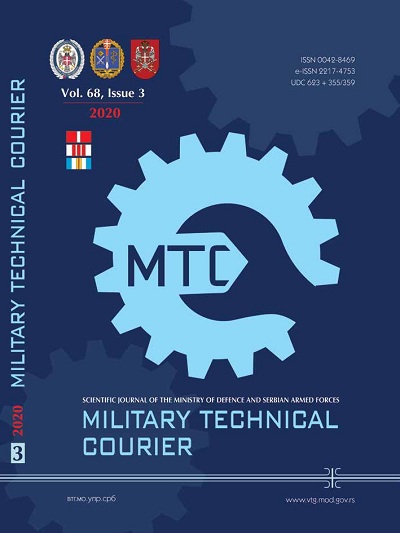Modulation transfer function in the analysis of electro-optical system performance
Abstract
Introduction/purpose: The Modulation Transfer Function (MTF) is a useful tool for an imaging system performance analysis. It is used in Electro-Optical (EO) system design, verification of targeted system parameters, but also in optimization tasks for systems under test. This methodology based on the linear systems theory allows the performance analysis of complicated EO systems to be divided into subsystems. In this paper, the MTF methodology will be presented and explained, followed by the measurements performed in the electro-optical laboratory. The MTF measurements were performed on three types of cameras in different spectral bands, after which the results were compared to the model expectations and theoretical limits for the imaging system. For one of the sensors, the limiting frequency was also measured using the USAF 1951 test target which allowed the comparison between the methods.
Methods: Laboratory measurements and theoretical mathematical calculations.
Results: Based on the laboratory and theoretical results, the measurement results were further analyzed.
Conclusion: The measurements have proven that the calculated cutoff frequency and the MTF curve represent the limit for the real measured system performance. Therefore, this study has confirmed that the MTF can be convenient for finding system limitations and bottlenecks and for increasing the overall performance of the system.
References
Boreman, G.D. 2001. Modulation Transfer Function in Optical and Electro-Optical Systems. Bellingham, WA: SPIE Press. PDF ISBN: 9780819480453, Print ISBN: 9780819441430. Available at: https://doi.org/10.1117/3.419857.
-CI Systems. 2012. METS - Modular Electro-Optical Test System. Cat. No. 607-5610H. Carrollton, TX, USA: CI Systems.
Daniels, A. 2018. Field Guide to Infrared Systems, Detectors, and FPAs, Third Edition. Bellingham, WA: SPIE Press. ISBN: 9781510618640.
Dufour, J.-Y. 2013. Intelligent Video Surveillance Systems. New Jersey, USA: John Wiley & Sons, Inc. Print ISBN:9781848214330, Online ISBN:9781118577851. Available at: https://doi.org/10.1002/9781118577851.
Fiete, R.D. 2010. Modeling the imaging chain of digital cameras. Bellingham. WA: SPIE Press. PDF ISBN: 9780819483362, Print ISBN: 9780819483393. Available at: https://doi.org/10.1117/3.868276.
Haefner, D.P. 2018. MTF measurements, identifying bias, and estimating uncertainty. In: Proc. SPIE 10625, Infrared Imaging Systems: Design, Analysis, Modeling, and Testing XXIX - SPIE Defense + Security, Orlando, FL, US, 1062506, April 26. Available at: https://doi.org/10.1117/12.2303974.
Hobbs, P.C.D. 2000. Building Electro-Optical Systems: Making it All Work. New Jersey, USA: John Wiley & Sons, Inc. Print ISBN: 9780471246817, Online ISBN: 9780471224297. Available at: https://doi.org/10.1002/0471224294.
Holst, G.C. 2008. Electro-optical imaging system performance, 5th edition. Winter Park, FL: JCD Publishing. ISBN: 9780970774965.
Holst, G.C. 2011. Imaging system fundamentals. Optical Engineering, 50(5), 052601. Available at: https://doi.org/10.1117/1.3570681.
Kohm, K. 2004. Modulation transfer function measurement method and results for the Orbview-3 high resolution imaging satellite. In: ISPRS Archives, XXth ISPRS Congress Technical Commission I, Istanbul, Turkey, 35, pp.7-12, July 12-23 [online]. Available at: https://www.isprs.org/proceedings/XXXV/congress/comm1/papers/2.pdf. [Accessed: 07 July 2020].
McDaniel, R., Hughes, R. & Seibel, E. 2006. EO/IR sensors enhance border security applications. In: Proceedings Volume 6203, Optics and Photonics in Global Homeland Security II - Defense and Security Symposium, Оrlando, FL, US, 620304, May 5. Available at: https://doi.org/10.1117/12.673678.
Pađen, N., Perić, D. & Milosavljević, M. 2019. Imaging System Performance Analysis Using Modulation Transfer Function. In: Sinteza 2019 - International Scientific Conference on Information Technology and Data Related Research, Novi Sad, Serbia, pp.567–574, April 20. Available at: https://doi.org/10.15308/Sinteza-2019-567-574.
Perić, D., Livada, B., Perić, M., & Vujić, S. 2019. Thermal Imager Range: Predictions, Expectations, and Reality. Sensors,19(15), 3313. Available at: https://doi.org/10.3390/s19153313.
Perić, D., Livada, B., Radisavljević, M. & Vujić, S. 2018. Performance Comparison of SWIR Vision Systems Using MTF Analysis. In: Proceedings of Papers – 5th International Conference on Electrical, Electronicand Computing Engineering, IcETRAN, Palić, Serbia, pp.762-765, June 11-14. ISBN: 978‐86‐7466‐752-1 [online]. Available at: https://www.etran.rs/common/Zbornik%20ETRAN%20IC%20ETRAN-18-final.pdf. [Accessed: 07 July 2020].
Schowengerdt, R.A., Archwamety, C. & Wrigley, R.C. 1985. Landsat Thematic Mapper image-derived MTF. Photogrammetric Engineering and Remote Sensing, 51(9),pp.1395-1406 [online]. Available at: https://www.asprs.org/wp-content/uploads/pers/1985journal/sep/1985_sep_1395-1406.pdf [Accessed: 07 July 2020].
Shumaker, D.L. & Wood, J.T. 1988. Overview Of Current IR Analysis Capabilities And Problem Areas. In: Proceedings Volume 0890, Infrared Systems and Components II, Los Angeles, CA, US, pp.74-80, May 3. Available at: https://doi.org/10.1117/12.944272.
-United States Department of Defense. 1950. MIL-STD-150A: Military Standard Photographic Lenses. Washington D.C: Armed Forces Supply Support Center.
Proposed Creative Commons Copyright Notices
Proposed Policy for Military Technical Courier (Journals That Offer Open Access)
Authors who publish with this journal agree to the following terms:
Authors retain copyright and grant the journal right of first publication with the work simultaneously licensed under a Creative Commons Attribution License that allows others to share the work with an acknowledgement of the work's authorship and initial publication in this journal.
- Authors are able to enter into separate, additional contractual arrangements for the non-exclusive distribution of the journal's published version of the work (e.g., post it to an institutional repository or publish it in a book), with an acknowledgement of its initial publication in this journal.
- Authors are permitted and encouraged to post their work online (e.g., in institutional repositories or on their website) prior to and during the submission process, as it can lead to productive exchanges, as well as earlier and greater citation of published work (See The Effect of Open Access).

